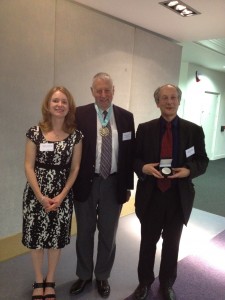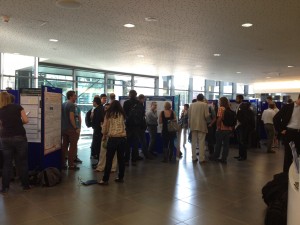Faraday Discussion 159 took place from 23rd to 25th July in Leeds, UK.
The first day got off to a good start with gloriously sunny weather in Leeds. The conference was kick-started by the Introductory Lecture on patchy particles by Daan Frenkel, 2012 Spiers Memorial Award winner, received with immense interest by the auditorium; and the meeting promptly proceeded to the first session on nucleation chaired by Nico Sommerdijk where six papers were introduced. Presentations by Helmut Cölfen, Peter Vekilov and James DeYoreo, among others, on pre- and post-nucleation mechanisms provoked a lively debate.

Prof. Fiona Meldrum (Chair of FD159 Scientific Committee), Prof. Graham Hutchings (President of the Faraday Society) and Prof. Daan Frenkel (Spiers Memorial Lecture prize winner).
Tuesday morning commenced with a session on self-assembly crystal growth mechanisms, chaired by Pupa Gilbert. Notable contributions were given by Alfons van Blaaderen on colloidal silica rods and by Bartosz Grzybowski on charged nanoparticles, followed by stimulating discussions.
The keen academic pace did not slow down in the afternoon session chaired by Hugo Christenson which provided insights into amorphous precursor phases, and included a notable dialogue between Kevin Roberts and Denis Gebauer on Laurie Gower’s paper on liquid precursor phase of calcium carbonate, which pulled in the whole audience into a thought-provoking and spirited communication.
The balmy Tuesday evening saw the start of the conference dinner being graced by an enthralling speech from Graham Hutchings, the current president of the Faraday Society. Fiona Meldrum, the Chairman of the discussion then announced that the Skinner Poster Prize was jointly awarded to Mark Bewernitz and Johannes Ihli.
The bright sunlight of Wednesday morning welcomed the last session on biological crystallisation mechanisms, chaired by Derk Joester. The discussions revolved around analysis of proteins extracted from fish skeleton and mollusc shell nacre. The presentation by John Spencer Evans focused specifically on the intra-crystalline protein family, Asprich. Jim DeYoreo from Lawrence Berkley Laboratory summed up the meeting highlights and offered new perception of much debated aspects of the discussion in his Concluding Remarks.
Lucy Gilbert and Tanya Smekal
The day got off to a good start with the gloriously sunny weather in Leeds. The conference was kick-started by the Introductory Lecture on patchy particles by Daan Frenkel, 2012 Spiers Memorial Award winner, received with immense interest by the auditorium; and the meeting promptly proceeded to the first session on nucleation chaired by Nico Sommerdijk where six papers were introduced. Presentations by Helmut Cölfen, Peter Vekilov and James de Yoreo, among others, on pre- and post-nucleation mechanisms provoked a lively debate.
Tuesday morning commenced with a session on self-assembly crystal growth mechanisms, chaired by Pupa Gilbert. Notable contributions were given by Alfons van Blaaderen on colloidal silica rods and by Bartosz Grzybowski on charged nanoparticles, followed by stimulating discussions.
The keen academic pace did not slow down in the afternoon session chaired by Hugo Christenson which provided insights into amorphous precursor phases, and included a notable dialogue between Kevin Roberts and Denis Gebauer on Lawrie Gower’s paper on liquid precursor phase of calcium carbonate, which pulled in the whole audience into a thought-provoking and spirited communication.
The balmy Tuesday evening saw the start of the conference dinner being graced by an enthralling speech from Graham Hutchings, the current president of the Faraday Society. Fiona Meldrum, the Chairman of the discussion then announced that the Skinner Poster Prize was jointly awarded to Mark Bewernitz and Johannes Ihli.
The bright sunlight of Wednesday morning welcomed the last session on biological crystallisation mechanisms, chaired by Derk Joester. The discussions revolved around analysis of proteins extracted from fish skeleton and mollusc shell nacre. The presentation by John Spencer Evans focussed specifically on the intra-crystalline protein family, Asprich. Jim de Yoreo from Lawrence Berkley Laboratory summed up the meeting highlights and offered new perception of much debated aspects of the discussion in his Concluding Remarks.
Lucy Gilbert and Tanya Smekal












